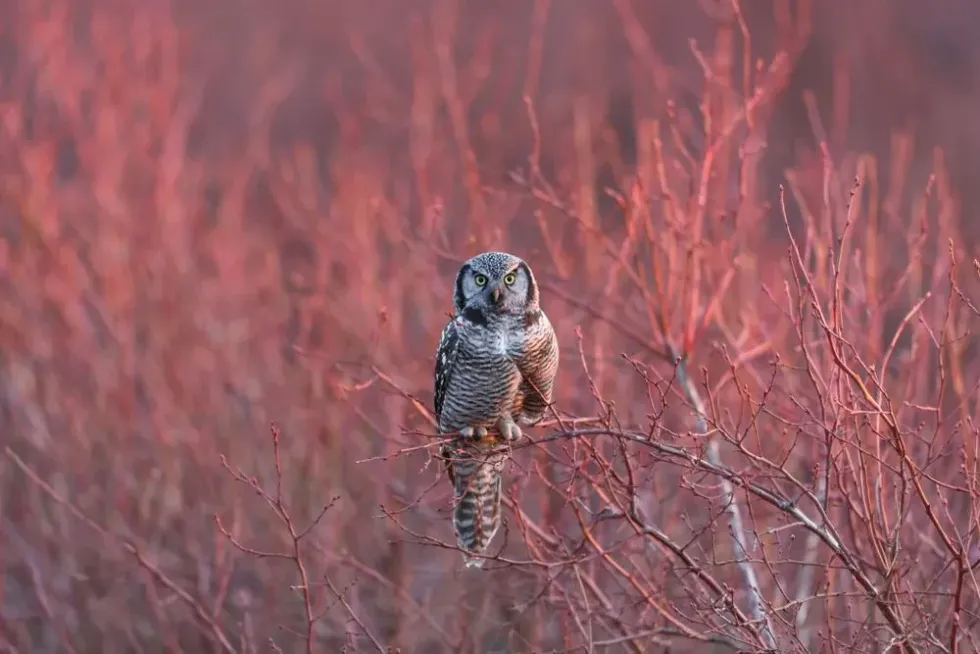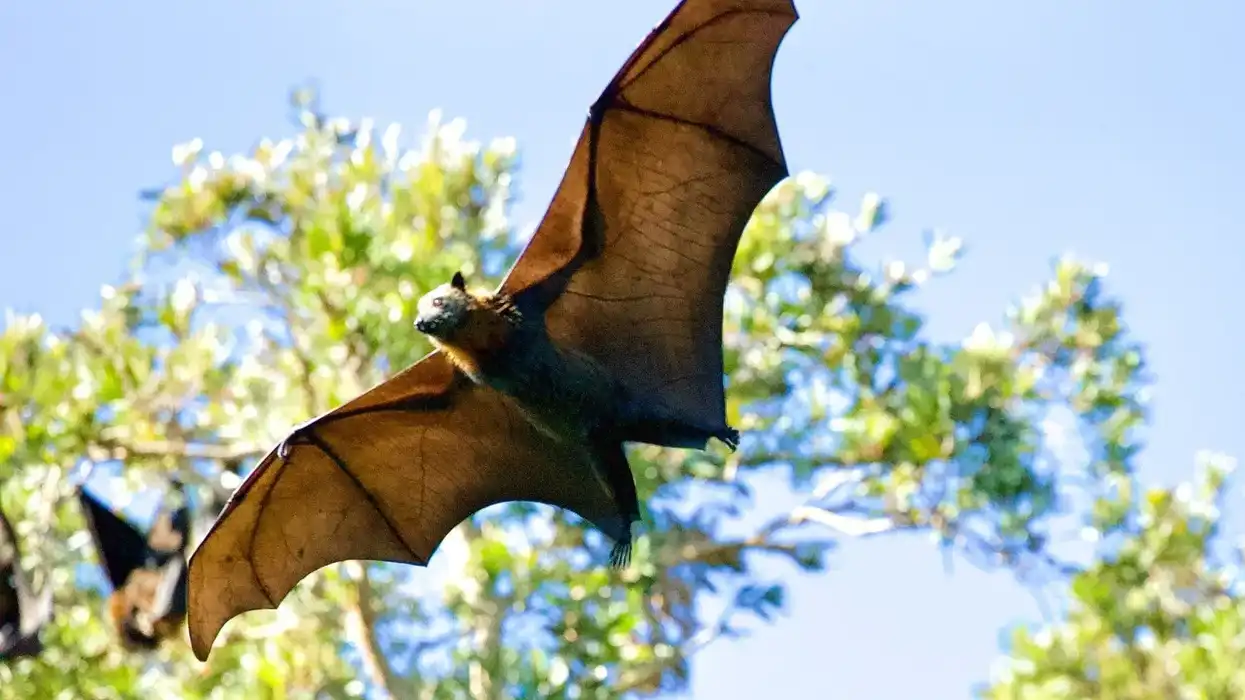The northern hawk (North American owl) is a bird that is famous for acting like a hawk but is an owl—hence the name. It catches prey primarily with the help of its sight.
Its tendency to hunt occurs within the daytime.
It has symmetrical ear openings cited as proof for daytime hunting—its ears are less sensitive to hearing than the asymmetrical ear openings of species like boreal owls and nice gray owls. Despite this, hawk owls can spot their prey by sound, even if it's under a foot of snow.
The Cornell Lab Of Ornithology has extensively studied these birds and published various reports studying their behavior, appearance, and the like. Read on to learn more!
Let's have a look at these interesting facts, and if you like these, do read our golden masked owl facts and barn owl facts.
Northern Hawk Interesting Facts
What type of animal is a northern hawk owl?
The northern hawk owl (Surnia ulula) is a medium-sized owl of the northern latitudes. It is not when it's dark and active during the day.
What class of animal does a northern hawk owl belong to?
This medium-sized owl, the northern hawk owl, belongs to the class Aves.
How many northern hawk owls are there in the world?
Partners In Flight, an organization that works towards protecting birds, states that an estimated 200,000 northern hawk owls exist in the world.
Where does a northern hawk owl live?
These hawk owl (Surnia ulula) birds are year-round residents of North America. They live within the northern boreal forest range of Alaska, Canada, and Newfoundland. The hawk (northern) owls move and adapt as per prey availability and atmospheric conditions.
What is a northern hawk owl's habitat?
Northern hawk owls' habitats are erratically distributed and extremely variable throughout the boreal forest range, hence, they are not native to a particular region. They live in a range of open cone-tree forests or cone-tree forests and deciduous species like larch, birch, poplar, and willow.
They have been found in a range of clearings, muskegs, meadows, swamp valleys, or burnt areas. The breeding occurs in their winter habitats.
Who do northern hawk owls live with?
They live with their nesting groups of the family Strigidae.
How long does a northern hawk owl live?
The lifespan of northern hawk owls is a maximum of ten years.
How do they reproduce?
The reproducing season for northern hawk owls begins early in March. The males establish a nesting territory and attract a mate by vocalization and displaying through flight. Once the hawk owl females show interest, the pair engages in mutual vocalizations, bill rubs (a behavior referred to as billing), and other displays before mating.
The hawk owl males catch the prey and bring it to the females. Like other northern owls, the hawk owls might not lay eggs if the prey is not found in abundance.
These breeding northern hawk owls build their nests inside the excavated cavities of dead trees and snags to lay eggs. For nesting, they use nest boxes, abandoned baskets, and nests of crows and different birds of prey.
Wood chips are shaped into the nest cavity to cushion the white and unmarked eggs of the clutch. The females alone incubate the clutch for 25-30 days; the males feed them for many days before the eggs get hatching. These breeding owls are fearless and aggressive toward nest intruders and will defend their nests vehemently.
Young birds hatch asynchronously with different-sized siblings within the nest. The parents take care of the juveniles who leave the nest 25-35 days after hatching.
What is their conservation status?
The northern hawk owl's status is Not Evaluated, hence, we can not tell if this bird's Endangered. Their habitat makes it hard to assess their population, but since they are said to be uncommon, we should work toward their conservation.
Northern Hawk Owl Fun Facts
What does the northern hawk owl look like?

The northern hawk owl plumage is dark brown with an off-white pattern on the upper side of the body, except the rear of the neck which boasts a black pattern. The underbelly is mostly white or off-white, with brown bands on the breast and abdomen.
It has a long tail with a dark brown band. This bird has a smokey white face with a black border, a flat head, orange-yellow eyes, and a yellow falcate beak.
How cute are they?
They are not very cute. They look scary to some with their orange-yellow eyes.
How do they communicate?
This owl (northern hawk) uses different types of calls utilized to communicate. The males let out whistles while attracting their mates. At a potential nest site, the female's call is shrill when alerting about danger. Then comes a high-pitched scream followed by a bark. The normal range of the call could be from 15 seconds to two minutes.
How big is a northern hawk owl?
The male hawk owl (northern) is usually 14.2–16.7 in (36–42.5 cm). The female hawk owl is slightly larger with a length of 14.6–17.6 in (37.2–44.7 cm). They have a wingspan of 18 in (45 cm). It is ten times bigger than drongo birds.
How fast can a northern hawk owl fly?
These northern hawk owls can fly very fast because when predators fly close to their nest site, the male bird typically chases them away. Their exact speed is not known.
How much does a northern hawk owl weigh?
A male northern hawk owl's average weight is 10.58 oz (300 g). The hawk owl females are slightly larger, weighing an average of 11.99 oz (340 g).
What are the male and female names of the species?
There are no specific names given to the male and female.
What would you call a baby northern hawk owl?
There is no specific name given to their baby. They are called owl northern hawk chicks or nestlings.
What do they eat?
Northern hawk owls eat prey such as voles, hares, squirrels, weasels, grouse, and numerous tiny birds.
Are they dangerous?
Northern hawk owls can be dangerous. These birds have very little worry about humans and can attack if they are approached too closely.
Would they make a good pet?
The northern hawk owl (North American owl) isn't a pet. They are wild birds, and it would be not easy to provide them with a similar habitat at home.
Did you know...
The northern hawk owl finds prey by sight up to a mile away.
The northern hawk owl generally wanders off as per prey availability.
The oldest recorded northern hawk owl was at least eight years old.
Patricia A. Duncan and James R. Duncan from the Cornell Lab Of Ornithology published their extensive study on this bird in 2014.
The northern hawk owl's adaptations
These birds have a silky set of feathers that ensures that they make no sound when they fly. This is an adaptation that allows stealthy stalking of their prey.
What biome does the northern hawk owl live in?
Northern hawk owls live in the biome of open coniferous trees or mixed forests with trees with perches.
Here at Kidadl, we have carefully created lots of interesting family-friendly animal facts for everyone to discover! Learn more about some other birds, including spotted sandpiper facts and Galapagos penguin facts.
You can even keep yourself busy at home by coloring in one of our free printable northern hawk owl coloring pages.










